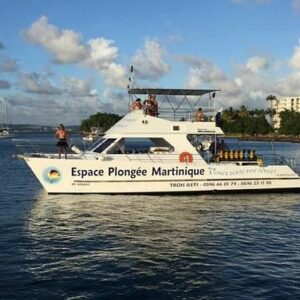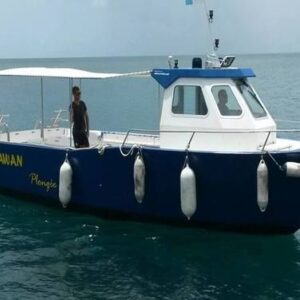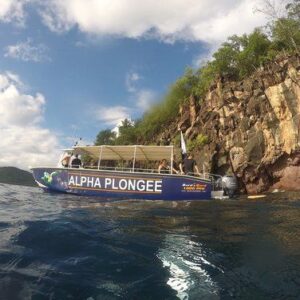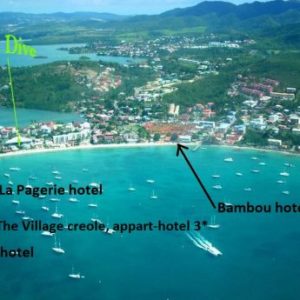Underwater Flora and Fauna – Volcanic Adventures – Family Diving
Martinique offers a one-of-a-kind experience for all levels of divers as well as family friendly diving activities. This hidden gem in the Caribbean offers divers a landscape that is as diverse and scenic below the waters as it is above the water. From exploring historic wrecks sunk by the most dramatic natural disasters, dives through the center of a towering volcanic spire to vibrant flora and fauna, Martinique is a scuba divers’ dream.
GETTING THERE
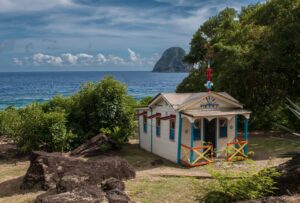
Air: 15 airlines fly to Martinique from France, Europe, the United States, Canada, and the Caribbean.
GETTING AROUND
Driving: Car rentals are available but there is a limited number of automatic cars available.
Taxis: There are no flat rates to destinations and rates tend to be very high.
Public Transportation: Martinique has no public transportation available.
Hire a Driver: This is often an additional service for those renting an Airbnb.
Ferries: Ferries run on regular schedules for low fares in different parts of the island
GOOD TO KNOW
Country: France
Time Zone: UTC-4
Primary Language: The official language is French, but most locals speak Creole.
Currency: Euro
Cell Phone Service: Roaming rates apply.
Voltage: 220v with C, D, and E sockets
Passport and Visa: Current valid ID card or passport for EU nationals. Valid passport for US citizens.
Hurricane Details: June-November / Martinique is located within the hurricane belt with August through October being the riskiest time for tropical storms.
DIVE CONDITIONS
Water Temperature: 79-84 degrees F
Water Visibility: 80 feet
When to Go: December – May
Diving Difficulty: Beginner – Advanced (Known for safe family diving opportunities)
TOP DIVE SITES IN MARTINIQUE
Martinique caters to the diving enthusiast! Listed are some of the very best that this island can offer divers:
- La Citadelle is suitable for all levels of divers and offers a rare opportunity to explore three different environments in succession. The first is an exceptional coral sand plateau between 20 to 100 feet where divers will observe an abundant and colorful fauna. Next, divers will drop 200 feet down a rocky drop off populated with sponges and gorgonians. Ending on the sea floor of black sand, divers can expect to see rock lobsters, turtles, and snappers.
- Les Canyons De Babodi owes its existence to the volcanic past of Mount Pelee. The lava flow created impressive canyons that extend 200 feet offshore. This site is suitable for all diving levels; however, it is recommended to be an advanced diver to access the bottom of the canyon.
- La Roraima is a 180 feet Canadian steam cargo shipwreck for advanced divers and is known as one of the top diving wrecks of Martinique. The Roraima burned for three days and 53 people perished due to the 1902 eruption of Mount Pelee. The wreck was discovered in 1974 and is well preserved. The flora at this site is deformed by the volcanic heat, the fauna is wide and varied and the dark red sponges have taken the form of a chimney. Divers will not only enjoy the wreck but also the white and orange gorgonians, trumpetfish, lizardfish, and schools of barracuda. This dive is worth doing more than once.
- La Cap Enrage (Enraged Cape) is accessible for all levels of divers and great for photographers. This 85-foot rocky dive offers drop offs containing coral gardens, gorgonians, sponges, and varied underwater fauna. The afternoon time is the best opportunity to observe all the fish from Martinique here. Divers will travel through a succession of canyons, corridors and caves and marvel at fish such as angel fish, scorpion fish and barracuda.
- Anses d’Arlet is home to the three mast Nahoon Shipwreck and is located along the island’s central coast. This explorable schooner purposely sank in 1993 and lies 120 feet below the water. Anses d’Arlet is home to the hawksbill turtle which is native to Martinique. Divers can expect to see a variety of sea life including kingfish, eels, and yellow headed jaw fish.
- The Great Caye of Sainte-Luce is located just southeast of Les Anses d’Arlet. This site offers divers the experience of exploring the reef-dwelling tropical marine life such as rock lobsters, parrotfish, butterfly fish, moral eels, and squid. The reef is 656 feet long and boasts a rich diversity in coral that is the best in the region. This dive is accessible for all levels of divers. It is a recommended night dive to witness the squid and other various crustaceans emerging from their hidden dwellings beneath the reefs and rocks.
- Le Cap Salomon (The Pool) is known for its white sand and sloping rock wall. This site is referred to as “the pool” due to its calm and serene waters and is perfect for all levels of divers, especially beginner divers. The underwater gardens are home to rock lobsters, spider crabs, and coral reef fish.
- Rocher di Diamont (Diamond Rock) is considered the most famous dive spot in Martinique. Most suitable for advanced divers, a 574-foot-tall rock formation is the result of volcanic activity. Divers can swim through the center of this massive and legendary site seeing beautiful caves, the famous arch, antique anchor, anemones, sea fans and hard corals.
- La Pointe Burgos is a magnificent plateau of coral located in a protected lagoon area. The site is accessible for all levels of divers and is known for having the most fish in the region. Barracudas, stingrays, eagle rays, mackerel, grunts, batfish, and sea breams can be spotted here. The flat sand is often used for scuba practice and instruction.
- Anse Dufour is a sheltered site that is accessible for all levels of divers. It is famous for the abundant array of marine life including dolphins, barracuda, stingrays, and turtles.
- Le Grandes Jorasses is available to advanced divers due to its strong currents. With a 200-foot rocky drop off, this site has unmatched visibility. Bigeye, mackerel, trevallies, and rays are on show here for divers.
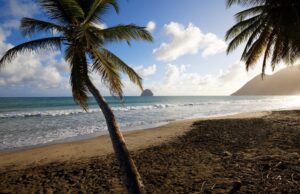
TOP ATTRACTIONS IN MARTINIQUE
- Saint-Pierre is built among the ruins of the former capital, Saint-Poerre. The former city was destroyed by the 1902 eruption of Mont Pelee which killed 30,000 residents apart from one prisoner. Today, visitors can explore the prisoner’s cell whose life was saved from the cell’s thick walls, the old theater, and the ruins of Le Figuier, a group of single-story houses. The Volcanological Museum (Musee Volcanologique) exhibits charred remains of salvaged articles from the old town and harbor. The favorite pastime of this area is the beaches, but the city also offers hiking including waterfalls and lush scenery, and delicious French and Creole cuisine.
- Les Trois-Ilets is a popular tourist area with plenty of hotels, restaurants, and several attractions. The Village de le Poterie des Trois-IIet centers around the history of the pottery industry. Housed in a former pottery yard where roof tiles used to be made, visitors can find art studios, small boutiques, shops, and restaurants. Maison de la Canne (House of Sugar) is an old sugar factory where visitors will learn about the history of sugarcane from slave trade to its later industrialization. Pointe de Bout is a tourist center with hotels, boutiques, and many dining options. The Anse Mitan is a favorite beach in the area.
- Sainte-Anne has the distinction of being the island’s southernmost village. The palm fringed coves are considered some of the prettiest areas on the island. The main attraction here is the beaches. At the tip of the peninsula, Des Pertrifications hosts a red earth landscape. Visitors can explore trails or visit Club Med Buccaneer’s Creek Sainte-Anne, the island’s most upscale and highly ranked resort.
- Fort-de-France is the capital of Martinique and the main port and launching point for sightseeing tours and other island adventures. One of the most visited attractions is Bibliotheque Schelcher. Named for Victor Schoelcher, an activist for the abolition of slavery in French colonies, this building was constructed in Paris for the 1889 World Exposition. It was disassembled and shipped to Martinique.
- Balata Botanical Garden (Jardin de Balata) features more than 3,000 species of tropical plants. Raised wooden rope bridges among the treetops allow visitors to view the lush gardens and hillsides of flowers, ponds with water lilies and lotus blossoms.
- La Savane des Esclaves (The Plain Slave) provides visitors with an accurate glimpse into life as a slave in Martinique. A reconstructed slave village of traditional huts with earth floors and sugar-cane leaf roofs depicts the history of slave housing on the island. Carved mahogany sculptures illustrate slaves attempting to escape and finally liberation. This living replica exhibits traditional skills and foods such as cacao, cassava, and sugarcane juice.
- Les Salines is named for the nearby salt pond; many consider it to be the best beach on the island. Located on the southern tip of Martinique, the calm waters, white sand, and arching coconut trees frame a perfect picture spot, picnic area, or rejuvenation place.
- Zoo de Martinique and Le Carbet are family friendly attractions. Zoo de Martinique is nestled among the ruins of an old sugar plantation. This small zoo includes animals such as monkeys, jaguars, and raccoons. Small paths and rope bridges lead visitors through tropical gardens and the animal enclosures. A highlight is the interactions with the colorful rainbow lorikeets. Le Carbet is a neighboring town known as the landing site of Christopher Columbus on June 15, 1502.
- Chateau Debuc and the Caravelle Peninsula are the former home and peninsula owned by the wealthy Debuc family during the 18th century. Surrounded by the remains of their vast sugar refinery, no other place tells the story of the island’s one mainstay industry. Visitors can use the interactive clickable map to hear detailed descriptions explaining each site from grinding of raw cane to the shipment of molasses from the plantation dock.
- Diamond Rock and Le Memorial de I’Anse Caffard holds an unusual slice of naval history. Sailors were dropped on the volcanic rock in 1804 by the British. The rock was registered as the ship HMS Diamond Rock. The French tried unsuccessfully for 17 months to remove the British troops and take back the island. Using a creative strategy, they finally were able to overpower the troops and take control of the island. Visitors can learn about the intriguing history of the rock at the nearby town of Le Diamant. The waters are too rough for swimming but are perfect for surfing. Le Memorial de I’Anse Cafard (the Anse Cafard Slave Memorial) is a tribute to the victims of the 1830’s shipwreck that killed most of the passengers including 20 slaves that were chained to the boat. Twenty statues staring out to sea remind all who visit here of the suffrage and turbulent history of the island.
- Musee de la Pagerie is the former sugar estate and birthplace of Marie Joseph Rose Tascher de la Pagerie. She would later become Napoleon’s Empress Josephine. The small cottage has been partially restored and includes personal items such as the marriage certificate and love letters from Napoleon. This attraction gives a great picture of wealthy colonial life in Martinique in the 18th century.
- Hike on Mount Pelee Volcano is a great way to enjoy spectacular views of the Atlantic, the surrounding mountains and the neighboring island of Dominica. Currently in a quiet phase, visitors can pick trails with varying degrees of difficulty with the most popular being Ajoupa Bouillon.
- St James Rum Museum represents the many rum distilleries on the island. This generous rum tasting bar provides visitors with the history of the production and promotion of cane liquor. The museum displays cases of reliquary bottles of rum from over the decade including bottles from before the 1902 volcanic eruption.
Martinique is a French Island Territory called the Land of Flowers. Its stunning white sandy beaches, small bays, romantic vibe, and unique culture makes this an undeniable relaxing and romantic haven. Dives characterized by historic shipwrecks, healthy reefs, rich and diverse flora and fauna and an abundance of sea life make this a perfect destination for everyone in the family.

